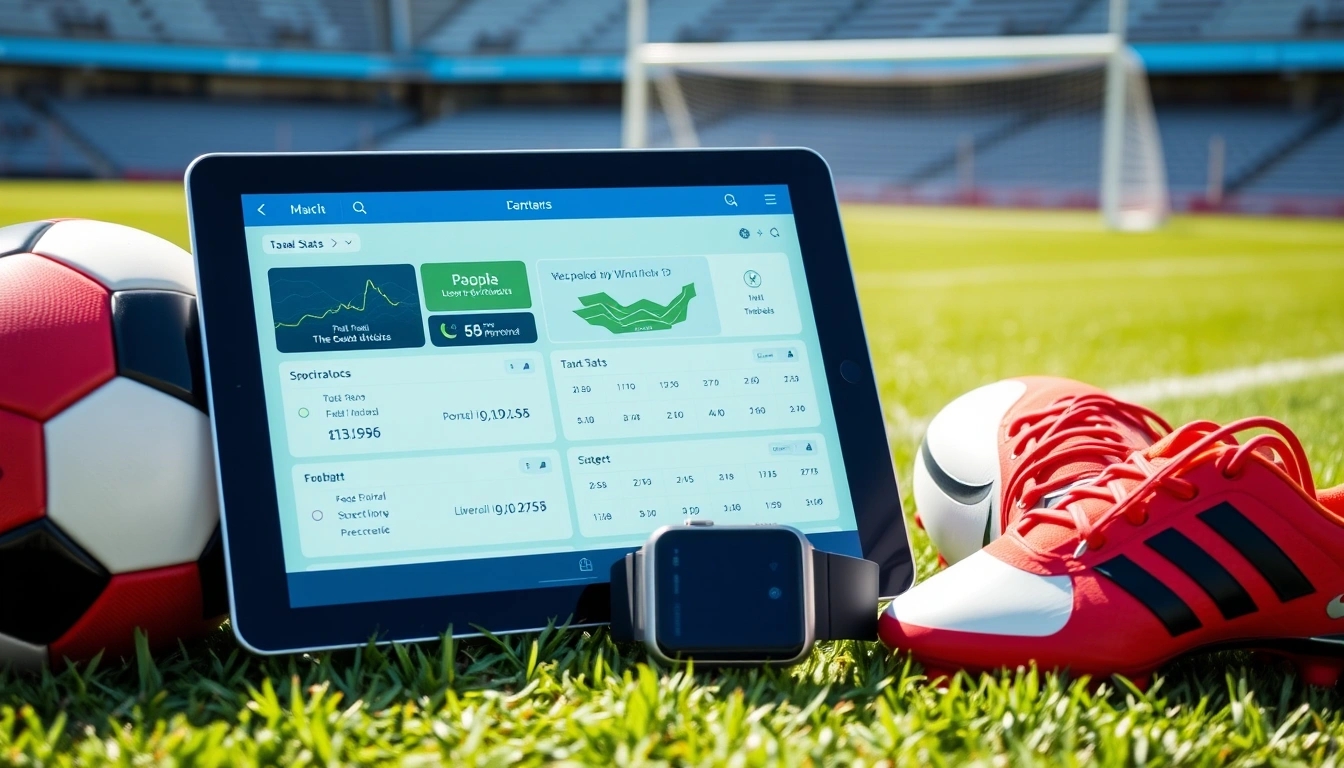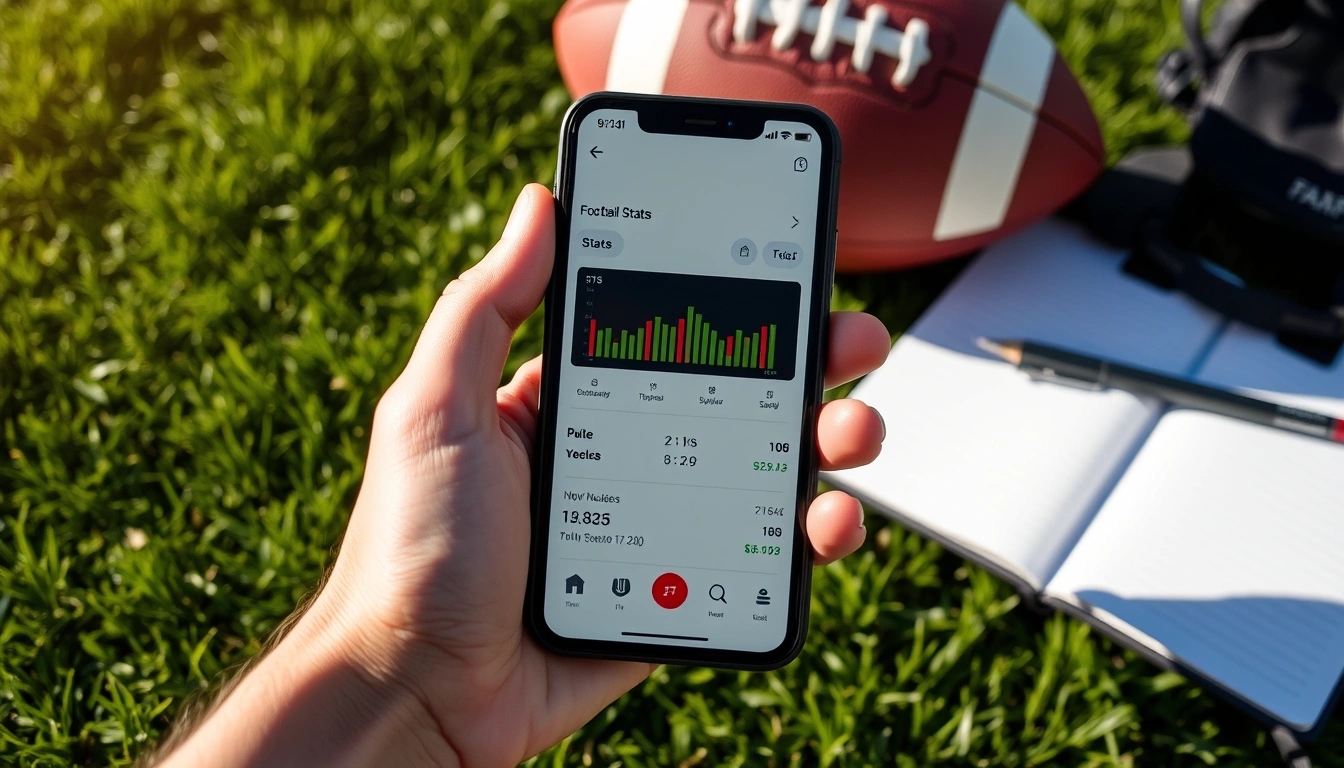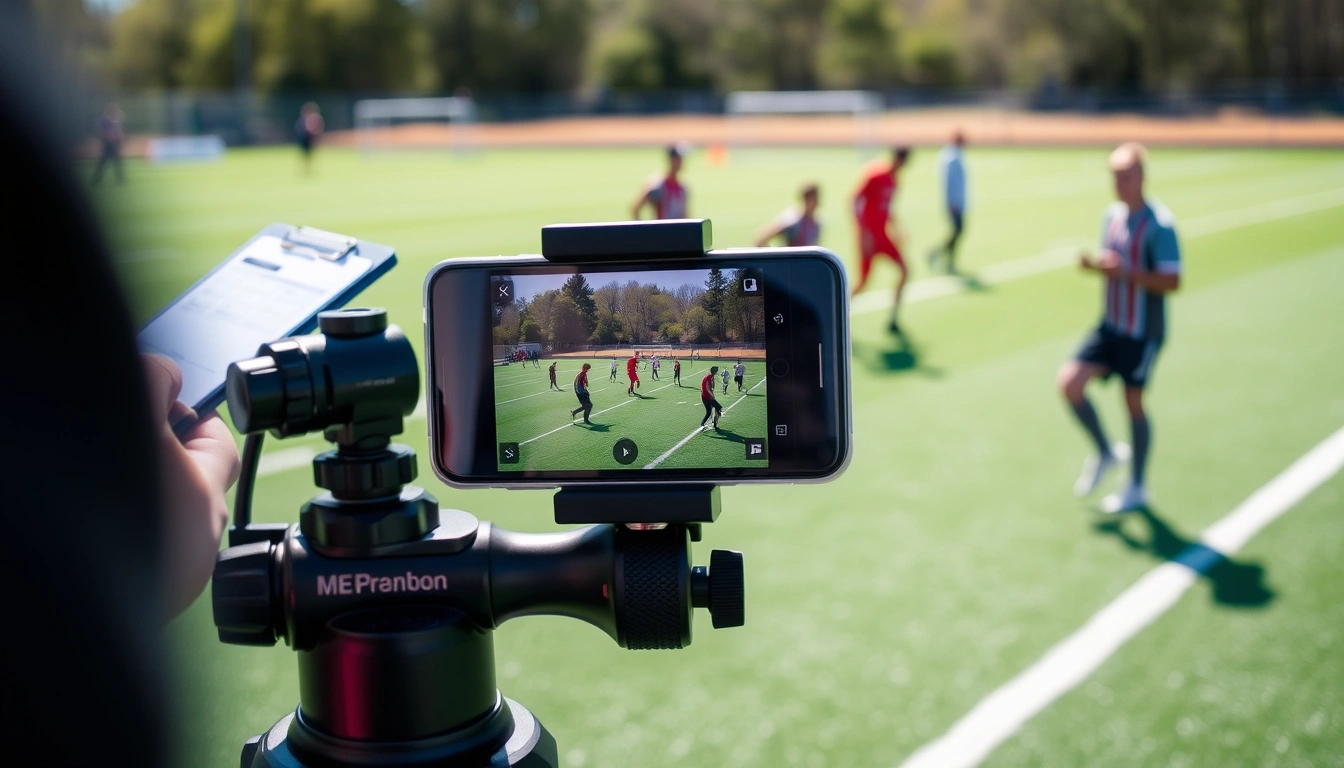Getting a grip on your football performance stats might feel like you’re trying to decode alien language. Honestly, it can be a bit overwhelming at first—numbers flying everywhere, percentages, averages, and whatnot. But don’t sweat it. This guide is here to break things down in a way that even your grandma could understand (assuming she’s into football). If you’re an amateur player who wants to keep tabs on how you’re really doing on the pitch, you’re in the right place. Let’s get into it.
Why bother tracking your stats?
You might be thinking, “Why should I care about stats? I just wanna play.” Fair enough. But here’s the kicker: stats give you a mirror. They show what’s working and what’s not. Maybe you think you’re scoring loads, but your assist numbers tell a different story. Or your defensive stats reveal you’re getting caught out of position more often than you realize. Knowing this stuff means you can focus your training smarter, not just harder. It’s like having a cheat sheet for your own game.
| Key Stats to Track | Why They Matter |
|---|---|
| Goals | Obvious measure of scoring ability. |
| Assists | Shows your teamwork and vision. |
| Tackles | Reflects defensive contribution. |
| Pass Completion % | Indicates accuracy and decision-making. |
| Shots on Target | Measures attacking threat. |
Now, if you’re thinking “I don’t have fancy tech or a coach to keep stats for me,” no worries. You can go old school with pen and paper. It’s not glamorous, but jotting down your numbers right after the match or even during halftime can be a game-changer. Just keep it simple. You don’t need to track every little thing—stick to the basics listed above.
- Tip 1: Use a small notebook or a stat tracking sheet on your phone.
- Tip 2: Focus on one or two stats each game to avoid overload.
- Tip 3: Ask a teammate or coach to help if possible—it’s easier with a buddy.
If you’re a techie, plenty of apps exist that turn stat tracking into a less painful experience. Apps like “My Football Stats” or “TeamSnap” offer easy interfaces to log your performance without needing a degree in data science. Some even let you upload video clips, so you can review your game later (more on that soon).
Turning numbers into goals
Tracking stats is only half the battle. The real magic happens when you use those numbers to set realistic goals. Don’t go wild expecting to double your goals overnight. Instead, maybe aim to improve your pass completion by 5% over the next month or increase your tackles per game. Small, manageable goals keep you motivated and prevent burnout.
Example Goal Setting Sheet:| Stat | Current | Target | Time Frame ||--------------------|---------|--------|-------------|| Goals per game | 0.5 | 0.7 | 1 month || Pass Completion % | 75% | 80% | 1 month || Tackles per game | 2 | 3 | 1 month |
Remember, it’s not about perfection. Sometimes you’ll have off days, and your stats will look like a hot mess. That’s okay. The key is consistency and learning from the numbers, not obsessing over them.
So, whether you’re scribbling notes on a napkin or using the latest app, tracking your football stats as an amateur player is totally doable—and it’ll give you a leg up on improving your game without losing your mind in the process.
Why tracking your football stats matters
Look, if you’re out there kicking the ball around just for fun, maybe stats aren’t your cup of tea. But if you want to level up, really see what’s going on in your game, then tracking your football stats is like having a secret weapon in your back pocket. It’s not just some boring numbers game—these stats can actually reveal what you’re smashing and what’s holding you back. Imagine knowing exactly how many shots you took versus how many actually hit the target, or how many tackles you won compared to the ones you lost. That info isn’t just trivia; it’s your personal cheat sheet to getting better.
Now, here’s a little table to break down what tracking can do for you:
| Benefit | What it Means for You |
|---|---|
| Identifies Strengths | Focus on what you’re already good at and keep sharpening those skills. |
| Highlights Weaknesses | Pinpoint areas needing work so you don’t waste time guessing. |
| Improves Training Focus | Tailor your drills to fix specific issues instead of random practice. |
| Tracks Progress | See real improvement over weeks or months, which keeps motivation high. |
| Boosts Confidence | Knowing your numbers helps you trust your game and decisions on the pitch. |
But hey, don’t get me wrong—tracking stats isn’t some magic pill. It can get overwhelming, especially when you’re juggling work, school, or just life in general. Sometimes you’ll miss a stat or two, or maybe you’ll feel like the numbers don’t really tell the whole story. And that’s fair! Football’s a fluid game, full of moments stats just can’t capture. But still, having a solid grasp on your key stats is way better than flying blind.
Here’s a quick list of the kind of stats that really matter for an amateur player:
- Goals scored — duh, the main event.
- Assists — because teamwork makes the dream work.
- Pass completion rate — shows how reliable you are.
- Tackles won — for the defenders and midfield warriors.
- Shots on target — shows how clinical you are in front of goal.
- Distance covered — a good indicator of your work rate.
Tracking these regularly can give you a crystal-clear picture of where you stand. Plus, when you see your stats improve, it’s like a little pat on the back that keeps you going. And if you’re not improving? Well, it’s a wake-up call to switch things up.
So, next time you’re out on the pitch, don’t just play—observe. Jot down those numbers, review them, and use them to fuel your training sessions. It might feel like a chore at first, but trust me, once you get into the groove, tracking your football stats will become one of your favorite parts of the game. Because at the end of the day, knowledge is power, and in football, that power can turn you from just another player into a game-changer.
Basic stats every amateur player should track
Alright, so you’ve decided to get serious about your football game, huh? Good call! But before you start dreaming of hat-tricks and highlight reels, let’s talk about the *real* stuff — the basic stats you absolutely need to keep an eye on. Forget the fancy analytics that pros use; for us mere mortals, it’s all about tracking the essentials that actually show how you’re doing on the pitch.
First up, goals. Yeah, it sounds obvious, but goals are the headline stat everyone notices. Scoring is what wins games, no doubt. But don’t get cocky if you’re not banging them in every match — there’s more to the story.
Next, assists. Helping a teammate score? That’s just as valuable. Assists show you’re thinking beyond yourself and contributing to team play. If you’re the kind of player who sets up chances, this stat will prove it.
Now, let’s talk defense — because football isn’t just about pretty goals. Tackles are your bread and butter here. Keeping track of how many successful tackles you make can tell you how well you’re disrupting the opposition. Just don’t get too aggressive and end up with a red card, alright?
Passes completed is another gem. It’s easy to forget, but accurate passing keeps the team ticking. Track your pass completion rate — how many of your passes actually reach a teammate versus how many get lost in the chaos. It’s a great way to gauge your decision-making and technical skill.
- Shots on target: Not every shot is a goal, but how many force the keeper to dive? This shows your shooting accuracy.
- Interceptions: Snatching the ball from opponents before they even get a chance to shoot? That’s pure skill.
- Dribbles completed: Fancy footwork matters! Count how many times you successfully beat a defender.
- Fouls committed and suffered: Keep tabs on this to avoid being the team’s villain or to spot when you’re getting targeted unfairly.
| Stat | Why It Matters | How to Track |
|---|---|---|
| Goals | Direct impact on the scoreboard | Count every goal scored in matches |
| Assists | Contribution to team success | Note who scored after your pass |
| Tackles | Defensive effectiveness | Record successful tackles made |
| Passes Completed | Maintains team possession | Track completed vs attempted passes |
| Shots on Target | Measures shooting accuracy | Count shots that require goalie saves |
Now, here’s a little secret — you don’t need to be a stat nerd or have a PhD in data science to track these. Just grab a notebook or use a simple app on your phone (more on that later), and jot down these numbers after each match or training session. Over time, you’ll start to see patterns — maybe your passing is sharp but your tackling is a bit sloppy, or you’re creating chances but missing the final shot.
Don’t be discouraged if your numbers aren’t world-class right away. Tracking these basics is about awareness, not perfection. It’s like having a mirror for your game — sometimes it’s flattering, other times, well, not so much. But either way, it’s invaluable for growth.
So, to wrap it up: goals, assists, tackles, passes, shots on target, interceptions, dribbles, and fouls — these are your bread and butter stats. Keep them close, track them honestly, and watch how your understanding of your game deepens. You might even surprise yourself. Now, get out there and start counting!

Tools and apps to simplify stat tracking
Alright, let’s be honest: keeping track of your football stats can sometimes feel like a full-time job. You’re out there chasing the ball, making plays, and then you have to remember all those numbers? Yikes! Luckily, technology has your back. There are plenty of user-friendly apps and gadgets designed to make stat tracking less of a headache and more like a fun addition to your football routine. No more scribbling on napkins or trying to recall who scored when — these tools do the heavy lifting for you.
First up, apps like My Football Stats and SoccerMeter are absolute lifesavers for amateur players. They’re built with simplicity in mind, so you don’t need a PhD in data analysis to use them. Just tap in your stats as you play or right after the match, and voilà — you get instant feedback on goals, assists, passes, tackles, and more. Some even give you cool visual charts to see your progress over time. It’s like having your own personal coach in your pocket.
- My Football Stats: Easy input, tracks a variety of stats, and offers shareable reports.
- SoccerMeter: Great for live tracking during games, with customizable stat categories.
- TeamSnap: Not just for stats, but also organizes your team schedule and communications.
If you’re a bit of a gadget geek, wearable tech can also spice things up. Devices like the Catapult Vector or Polar GPS sensors provide real-time data on distance covered, sprint speed, and heart rate. Sure, they’re a bit pricier, but if you’re serious about leveling up, they’re worth considering. Imagine knowing exactly how much ground you covered in that last match or how your stamina held up in the final minutes — it’s a game changer.
| Tool/App | Key Features | Best For | Price |
|---|---|---|---|
| My Football Stats | Simple stat input, progress charts, shareable reports | Beginners & casual players | Free with in-app purchases |
| SoccerMeter | Live game tracking, customizable stats | Players wanting detailed in-game data | Free / Premium options |
| Catapult Vector (Wearable) | GPS tracking, speed, distance, heart rate | Competitive players & fitness enthusiasts | High-end pricing |
But hey, if you’re the type who likes to keep things old-school but still tech-savvy, consider using a simple spreadsheet app like Google Sheets or Excel on your phone or tablet. You can create your own stat tracking template — customize it to your style, add formulas to automatically calculate averages or percentages, and even share it with your coach or teammates. It’s a bit more hands-on but gives you full control over what you track.
Example basic stat tracking sheet layout:| Match Date | Goals | Assists | Passes Completed | Tackles | Shots on Target | Minutes Played ||------------|-------|---------|------------------|---------|-----------------|----------------|| 2024-03-10 | 2 | 1 | 35 | 5 | 4 | 90 || 2024-03-17 | 1 | 0 | 28 | 7 | 3 | 85 |
The bottom line? Don’t let stat tracking stress you out. Whether you’re tapping on an app, strapping on a GPS tracker, or jotting down numbers on a spreadsheet, the key is to find a system that feels less like a chore and more like a cool part of your football journey. Because when you enjoy the process, you’re way more likely to stick with it — and that’s where the real improvement happens.
Manual tracking: pen, paper, and patience
Alright, let’s get real for a second—sometimes, the best way to keep track of your football stats isn’t some fancy app or gadget. Nope, it’s the good old-fashioned method: pen, paper, and a whole lot of patience. Sounds a bit retro, right? But trust me, there’s something satisfying about scribbling down your numbers as the game unfolds or right after it ends. Plus, it keeps you connected to the game in a way that screens just can’t match.
Now, before you roll your eyes and say, “Who’s got time for that?” hear me out. Manual tracking can actually be super effective if you get the hang of it. The trick is to keep it simple and organized so you don’t end up drowning in a sea of illegible notes or missed details.
- Choose your weapon: Grab a small notebook or even a pre-made stat sheet—something portable and easy to flip through during halftime or after the match.
- Focus on key stats: Don’t try to write down everything under the sun. Stick to essentials like goals, assists, tackles, passes completed, and maybe fouls. Less is more when you’re doing this by hand.
- Develop a shorthand: Invent your own quick symbols or abbreviations. For example, “G” for goals, “A” for assists, “T” for tackles. This saves time and keeps you in the game rather than buried in notes.
Here’s a simple example of what your stat sheet might look like:
| Player | Goals (G) | Assists (A) | Tackles (T) | Passes Completed (PC) | Fouls (F) |
|---|---|---|---|---|---|
| John | 2 | 1 | 3 | 15 | 0 |
| Mike | 0 | 0 | 5 | 20 | 1 |
| Sarah | 1 | 2 | 2 | 18 | 0 |
One thing to keep in mind: it’s easy to get overwhelmed if you try to catch every single detail live during the match. So, if you’re playing and tracking your own stats, maybe jot down rough notes during breaks or right after the game instead of mid-action. Your brain (and fingers) will thank you.
And hey, don’t sweat the occasional missed stat or messy handwriting. This isn’t a college exam. The goal is progress, not perfection. Over time, you’ll figure out what works best for you and develop a rhythm. Some players even enjoy going back over their notes after the game, spotting trends or moments they might’ve missed in the heat of play.
Tips for surviving manual stat tracking:- Keep your notebook handy but unobtrusive.- Practice your shorthand during training sessions.- Review and organize your notes ASAP after the game.- Don’t stress about being 100% accurate every time.- Share your notes with teammates or coaches for feedback.
So yeah, manual tracking might feel a bit old school, but it’s a solid way to stay engaged and really understand your performance. Plus, it’s a cool skill to brag about—“Oh, you use an app? I prefer the pen and paper method, keeps me sharp!”
In the end, whether you’re a tech junkie or a traditionalist, the key is to keep tracking in a way that feels natural and sustainable. Because stats aren’t just numbers—they’re your story on the pitch, written one goal, one tackle, and one pass at a time.
Setting realistic goals based on your stats
Alright, so you’ve been tracking your football stats for a bit now — goals scored, passes completed, tackles won, and maybe even those sneaky offside calls that ruin your day. But what’s next? How do you turn those raw numbers into goals that actually mean something? Let’s get real: setting goals isn’t just about dreaming big and hoping for the best. It’s about using your tracked data to push yourself forward without falling flat on your face because you aimed way too high. Here’s the lowdown.
Step 1: Understand Your Baseline
Before you start shouting “I’m gonna score 30 goals this season!” look at your current stats honestly. What’s your average goals per match? How consistent are your assists or tackles? This baseline is your reality check. If you scored 5 goals last season over 20 games, expecting a 600% increase overnight might be a tad optimistic.
| Stat | Current Average | Realistic Goal |
|---|---|---|
| Goals per Game | 0.25 | 0.35 |
| Assists per Game | 0.3 | 0.4 |
| Tackles per Game | 2 | 2.5 |
Step 2: Set SMART Goals
You’ve heard it a million times — goals should be Specific, Measurable, Achievable, Relevant, and Time-bound. But here’s the catch: don’t just slap on numbers because they sound cool. Make sure they fit your playing style and training schedule. For example, if you’re a defender, setting a goal about assists might be less relevant than improving interception rates.
- Specific: “Improve my pass completion rate from 75% to 80%.”
- Measurable: Track pass completion after each match.
- Achievable: A 5% increase is challenging but doable.
- Relevant: Passing is key to your midfield role.
- Time-bound: Achieve this in the next 10 matches.
Step 3: Avoid the “All or Nothing” Trap
Look, football isn’t an exact science. Some days you’ll smash your target, other days you might barely touch it. If you set goals that are too rigid, you’re just setting yourself up for disappointment and frustration. Instead, think of your goals as flexible guides. If your stats dip, maybe tweak your goal rather than giving up entirely. Progress isn’t a straight line.
Example:Goal: Increase tackles per game from 2 to 3 in 5 matches.Reality: After 3 matches, average is 2.2.Adjustment: Aim for 2.5 tackles per game in the next 5 matches.
Step 4: Celebrate Small Wins
Don’t wait until you hit a massive milestone to give yourself a pat on the back. Every extra assist, every improved pass accuracy, every successful tackle counts. Use your tracked stats to highlight these small victories — they keep motivation alive and remind you that you’re moving forward, even if it’s baby steps.
Step 5: Keep Reviewing and Resetting
Your football journey isn’t static, and neither are your goals. Regularly analyze your stats, see what’s working and what’s not, and adjust accordingly. Maybe your goal of scoring more goals turns into a focus on better positioning or stamina. The key is to stay flexible and honest with yourself.
Quick Tips to Keep in Mind:
- Don’t compare yourself to pros—compare to your own past performance.
- Use your stats to spot trends, not just one-off games.
- Pair your numerical goals with practical training plans.
In the end, setting realistic goals based on your stats is like having a GPS for your football journey. It shows you where you are, where you want to go, and the best route to get there — but remember, sometimes you gotta take the scenic route and enjoy the ride.

Analyzing your stats to improve gameplay
Alright, let’s get real for a second — raw numbers on a sheet don’t magically make you a better footballer. You can’t just stare at a bunch of stats and expect your skills to level up overnight. But here’s the kicker: when you actually dig into those numbers and figure out what they’re telling you, that’s when the magic starts happening. It’s like having a secret playbook tailored just for you, showing what’s working and what’s tripping you up.
First off, don’t just focus on the flashy stuff like goals or assists. Sure, scoring is cool, but what about the stuff that’s less obvious? Tackles, interceptions, pass accuracy — these little nuggets reveal the backbone of your game. For example, if your pass completion rate is tanking, maybe it’s time to work on your vision or decision-making under pressure. Or if you’re winning loads of tackles but not helping much in attack, maybe balance is your missing ingredient.
| Stat | What it Shows | How to Use It |
|---|---|---|
| Pass Accuracy | How often your passes reach a teammate | Work on precision and choosing smarter passes |
| Tackles Won | Effectiveness in regaining possession | Boost defensive positioning and timing |
| Shots on Target | Quality of your shooting | Practice shooting under pressure |
| Distance Covered | Physical effort during the game | Improve stamina and positioning to conserve energy |
Now, here’s a little secret: stats only help if you’re honest with yourself. You might think you’re killing it with high numbers, but if you’re ignoring the context — like the quality of opposition or your role in the team — you’re just fooling yourself. Take a moment after each game to ask, “Did these numbers really reflect how I played?” Sometimes, they don’t.
- Look for patterns: Are you consistently losing possession in midfield? That’s a red flag.
- Compare games: Did your passing improve after that extra training session? Keep track!
- Set mini-goals: Instead of just “score more goals,” aim for “increase successful passes by 10%.”
And don’t forget, stats are your friend, not your enemy. If you get overwhelmed, just pick a couple of key metrics to focus on each week. Trying to track everything is like juggling flaming torches — likely to end in tears. Also, mixing video analysis with stats can be a game-changer. Watching clips of your performance while checking the numbers helps you see where you hesitated or rushed.
Example: - Game 1: Pass accuracy 75%, 2 tackles won, 1 shot on target- Game 2: Pass accuracy 82%, 3 tackles won, 0 shots on targetInsight: Improved passing, better defense, but need to be more aggressive in attack.
In the end, stats are just a tool. They won’t make you Messi or Ronaldo overnight, but they sure as heck can point you in the right direction. Play smarter, not just harder — that’s the real takeaway. So, grab your notebook, fire up that app, and start turning those numbers into your personal playbook for success.
Remember: It’s all about progress, not perfection. Keep tracking, keep tweaking, and watch your game evolve one stat at a time.
Common mistakes in stat tracking and how to avoid them
Alright, let’s be honest here — tracking your football stats isn’t exactly rocket science, but it sure can feel like a juggling act if you’re not careful. Many amateur players dive headfirst into stat tracking with the best intentions, only to get tangled up in a mess of inconsistent numbers, pointless stats, or just plain confusion. So, let’s cut through the noise and talk about the most common pitfalls and how you can dodge them like a pro defender.
- Inconsistent Tracking: This is the classic trap. One week you’re all over it, noting every pass and tackle, next week? Nada. It’s like trying to fill a bucket with holes in it. To avoid this, set a simple routine—maybe jot stats right after the game or during halftime. Consistency beats perfection every time.
- Focusing on the Wrong Stats: Not all numbers are created equal. If you’re obsessing over how many times you touched the ball but ignoring key stats like successful passes or defensive clearances, you’re missing the point. Prioritize stats that actually reflect your role and impact on the pitch.
- Overcomplicating Things: Some folks try to track every tiny detail, turning their notebooks into a labyrinth of numbers. Trust me, this quickly becomes overwhelming and useless. Stick to a handful of meaningful stats. Quality over quantity.
Here’s a quick table to help you decide what to track and what to skip, depending on your position:
| Position | Must-Track Stats | Stats to Avoid Obsessing Over |
|---|---|---|
| Forward | Goals, Shots on Target, Assists | Passes Completed (unless very high) |
| Midfielder | Pass Completion %, Key Passes, Tackles | Goals (unless you’re an attacking mid) |
| Defender | Tackles Won, Clearances, Interceptions | Shots on Target |
Another hiccup is letting emotions cloud your judgment. After a rough game, it’s tempting to downplay your stats or skip tracking altogether. Don’t. Stats are your friend, not your enemy. They don’t judge you—they just show what happened. Use them to learn, not to beat yourself up.
- Neglecting Context: Numbers alone don’t tell the whole story. Did you miss a few tackles because the opposing team was just on fire? Maybe. Always try to pair stats with notes on the game situation.
- Ignoring Video Review: If you’re not double-checking your stats with video footage, you’re missing a chance to catch errors or see things you didn’t notice live. Even a quick replay on your phone can clarify a lot.
Finally, don’t get stuck in the “stats are everything” mindset. Football’s a fluid, messy game. Stats help, but they don’t replace good old-fashioned instincts and teamwork. Keep it simple, stay consistent, and focus on what truly matters to your game. That’s the secret sauce to turning your stat tracking from a headache into a handy tool.
Creating a simple stat tracking sheet
Alright, so you’ve decided to take your football game seriously and want to keep track of those stats like a pro. But where do you even start? Don’t worry, building a spreadsheet to organize your football stats isn’t rocket science — it’s more like assembling a pizza. You just need the right ingredients and a little patience. Here’s a step-by-step guide to get you rolling.
Step 1: Choose Your Platform
First off, pick your weapon. Microsoft Excel, Google Sheets, or any free spreadsheet tool will do. Google Sheets has the edge because it’s cloud-based, so you can update your stats on the go from your phone or laptop without losing your mind over syncing.
Step 2: Lay Down the Columns
Think of your spreadsheet as a table where each column is a stat category. Here’s a quick list of basics you might want:
- Date – When was the match or training session?
- Opponent/Team – Who were you playing against?
- Goals Scored
- Assists
- Tackles
- Passes Completed
- Shots on Target
- Minutes Played
- Notes – For anything unusual or to jot down thoughts.
| Date | Opponent | Goals | Assists | Tackles | Passes Completed | Shots on Target | Minutes Played | Notes |
|---|---|---|---|---|---|---|---|---|
| 2024-04-10 | Red Tigers | 2 | 1 | 3 | 25 | 4 | 90 | Felt strong, but missed a few passes |
Step 3: Input Your Data Regularly
Here’s the kicker — the spreadsheet is only as good as the data you put in. Try to update it right after games or practice while the memories are fresh. Procrastinating? You’ll forget half your good plays (or bad ones, but hey, honesty is key). If you’re lazy like me, set a reminder on your phone.
Step 4: Use Simple Formulas to Summarize
Don’t get scared by the word “formulas.” You don’t need to be a math wizard. A simple “SUM” function can add up your goals or assists over the season. Like this:
SUM(C2:C20)
This adds all the goals listed from row 2 to 20 in column C. Easy peasy.
Step 5: Add Conditional Formatting for Visual Cues
Want to see when you had a killer game? Use conditional formatting to color-code high numbers. For example, highlight cells with goals greater than 2 in bright green. It’s like your spreadsheet is giving you a high-five.
Bonus Tips:
- Keep it simple: Don’t overload your sheet with stats you don’t understand or can’t track reliably.
- Back it up: Save a copy somewhere safe. Losing your stats is like losing your playbook.
- Make it fun: Add emojis or little notes. Hey, if it keeps you coming back, why not?
In the end, your stat tracking sheet is your personal scoreboard and diary rolled into one. It’s not about perfection but progress. So, get cracking, and who knows? Maybe your next spreadsheet update will be the one that catches your coach’s eye. Just remember: stats don’t lie, but sometimes they exaggerate a little — so keep it real, and keep playing hard.

Using video footage to enhance your stats tracking
So, you’ve been scribbling down your match stats on the back of whatever’s handy — napkins, old receipts, your mum’s grocery list — and feeling like you’re barely scratching the surface of what’s actually going on in your game. Well, here’s a game-changer: recording your matches. Yup, grabbing your phone or a camera and hitting record might just be the secret sauce you didn’t know you needed. Why? Because video footage doesn’t just capture moments, it captures details that your memory or quick note-taking might totally miss.
Think about it: you’re running around the pitch, heart pounding, trying to remember if you made that killer pass or if you actually blew that defensive tackle. Later, when you watch the footage, you can slow things down, rewind, and pick apart every move. Suddenly, those “maybe I did” or “I think I did” moments turn into concrete evidence. This means you’re not just guessing your stats; you’re verifying them. And that’s a big deal if you want to track your progress seriously.
| Benefits of Using Video Footage | How It Helps Your Stats |
|---|---|
| Replay & Slow Motion | Catch every pass, tackle, or shot you might’ve missed live. |
| Objective Review | Removes bias or “I was amazing” delusions from your stats. |
| Detailed Analysis | Break down positioning, movement, and decision-making. |
| Shareability | Easy to send clips to coaches or teammates for feedback. |
Now, don’t get me wrong — recording every single match might feel like a chore, especially if you’re juggling work, life, and trying to stay sane. But even just filming key moments or your own position on the field can be super insightful. Plus, it’s a great way to keep yourself honest. Ever thought you had 3 assists but the footage shows just 1? Yeah, that’s the kind of reality check that pushes you to improve.
- Pro tip: Use a tripod or prop your phone somewhere stable to avoid shaky footage — unless you want to feel seasick watching it back.
- Try apps that let you tag moments live during the match, so you don’t have to sift through hours of video later.
- Combine your footage with your written stats to spot trends — maybe you’re nailing passes but missing defensive cues.
Here’s a quick checklist to get started:
1. Choose your recording device (smartphone, camera, or tablet).2. Pick a good filming spot with a clear view of the action.3. Record the entire match or specific segments.4. After the game, watch the footage with your stat sheet handy.5. Adjust your stats based on what you see.6. Share clips with your coach or friends for extra insights.
In the end, video footage is like having a replay button for your own football journey. It adds a whole new layer of insight, helps verify your numbers, and can even boost your motivation when you see real progress on screen. So next time you’re out there, don’t just play — record, review, and rise.
Sharing your stats with coaches and teammates
Look, if you’ve been grinding on the pitch and keeping a close eye on your football stats, the next logical step is to share that hard-earned data. But why bother? And how do you do it without sounding like you’re bragging or turning your teammates off? Well, here’s the lowdown. Sharing your stats isn’t just about showing off—it’s about opening a channel for feedback, sparking motivation, and sometimes, just maybe, catching the eye of someone who could change your football journey forever.
First off, feedback is gold. Coaches, especially, love numbers because they cut through the fluff. When you bring your stats to the table—whether it’s goals scored, pass accuracy, or tackles won—you’re giving them concrete info to work with. It’s like handing over a cheat sheet that highlights your strengths and points out areas where you might be floundering. And don’t worry, no one’s expecting perfection. Coaches appreciate honesty and initiative. So, sharing your stats can lead to tailored advice, better training plans, and ultimately, a sharper game.
- Tip #1: Present your stats clearly. Use tables or simple charts to avoid confusion.
- Tip #2: Be open to criticism. Remember, it’s about growth, not ego.
- Tip #3: Share regularly, not just once. Consistency shows dedication.
Now, onto your teammates. Sharing stats with them can be a double-edged sword. It can spark friendly competition, which is great, but it can also cause friction if someone feels overshadowed. The trick? Use your stats to motivate, not to boast. For example, if you notice your pass completion rate is high, encourage your teammates by suggesting drills that helped you improve. Make it a team effort, not a solo victory lap.
| Why Share Stats? | How to Share Effectively |
|---|---|
| Get constructive feedback from coaches | Bring printed sheets or digital summaries to training sessions |
| Motivate and encourage teammates | Highlight team-wide stats, not just personal achievements |
| Attract scouts or talent spotters | Keep your stats updated and professional-looking, share on social media or football forums |
And here’s a little secret: scouts are always lurking, sometimes in the most unexpected places—social media, local match reports, or even casual chats with coaches. If your stats are solid and you share them confidently, you might just get that call or message. But don’t get cocky; stats are a tool, not a ticket. Combine them with hustle, attitude, and teamwork.
So, bottom line? Don’t hoard your stats like a dragon guarding treasure. Share smartly, share often, and let those numbers work for you. Whether it’s for feedback, team spirit, or a future career break, your stats are more than just numbers—they’re your story on the pitch.
Quick checklist before sharing your stats:
- Double-check for accuracy (no one likes a stat fibber!)
- Keep the presentation neat and simple
- Be ready to discuss and explain your numbers
- Use stats as a conversation starter, not a mic drop moment
Remember, football’s a team game, and your stats should help everyone get better—not just you. So go on, share away, and watch the magic happen.
Keeping motivated through stats tracking
Tracking your football stats can sometimes feel like watching paint dry — especially when the numbers don’t exactly scream “legend in the making.” But hey, don’t toss that notebook or close that app just yet! Staying pumped about your stats, even when progress seems snail-paced or your numbers look more “meh” than “wow,” is totally doable. Here’s the lowdown on how to keep your motivation engine running, no matter what those digits say.
- Celebrate the small wins. Did you make one extra successful tackle? Or maybe your pass accuracy improved by a tiny margin? Those little victories add up, trust me. Keep a separate “wins” log to remind yourself that progress isn’t always about the big flashy goals.
- Mix up your stats focus. If you’re stuck obsessing over goals scored but they’re not coming, shift the spotlight to assists, interceptions, or even your work rate. It’s like changing the channel when the show’s boring — fresh stats can keep things interesting.
- Visualize your journey. Create charts or graphs that show your progress over weeks or months. Seeing a line inch upward, no matter how slow, is way more motivating than staring at raw numbers on a spreadsheet.
| Common Motivation Killers | How to Combat Them |
|---|---|
| Feeling stuck with no improvement | Set micro-goals and track different stats to spot subtle gains |
| Overwhelmed by too much data | Focus on 2-3 key stats per game to avoid burnout |
| Comparing yourself to others | Remember your own journey; use stats to compete with past you, not others |
Now, don’t get me wrong — it’s perfectly normal to feel a bit disheartened when your stats look like they’re stuck in quicksand. The trick is to not let those numbers define your entire football story. Sometimes, the stats don’t capture the grit, hustle, or those “almost” moments that don’t make the highlight reel but are crucial to your growth.
Here’s a quirky little tip: try turning stat tracking into a game itself. Challenge yourself to beat your previous records or to hit new personal bests in less obvious areas like “successful dribbles” or “distance covered.” Make it fun! Because if stats feel like a chore, motivation will vanish faster than a defender in a 1-on-1.
Example Micro-Goal Tracker:| Stat Category | Last Match | Target Next Match | Actual Next Match ||--------------------|------------|-------------------|-------------------|| Successful Passes | 20 | 25 | || Tackles Won | 5 | 7 | || Shots on Target | 2 | 3 | |
Lastly, don’t keep your stats a secret. Share your progress with friends, teammates, or your coach. Getting feedback or even a bit of friendly banter can inject fresh enthusiasm. Sometimes, all you need is someone else to say, “Hey, you’re killing it!” to reignite that fire.
So, in a nutshell: keep your eyes on the small wins, shake up your stat focus, and turn tracking into a game rather than a grind. Your stats are there to serve you — not the other way around. Keep at it, and soon enough, those numbers will start telling the story you want.

Long-term benefits of tracking your football stats
Alright, let’s cut to the chase. Keeping tabs on your football stats might sound like a drag, especially when you’re just out there trying to enjoy the game. But trust me, over months and years, this little habit can turn into your secret weapon—not just on the pitch, but off it too. You might start off tracking goals or assists and then suddenly realize you’re building a treasure trove of info that could seriously shape your entire football journey. No joke.
First off, consistency is king. When you track your stats regularly, you get a crystal-clear picture of your progress. It’s like having a personal highlight reel and a reality check rolled into one. You’ll spot patterns—maybe your passing accuracy dips after a certain minute, or your tackles improve dramatically after a new training drill. Without stats, you’re basically guessing. And guesswork in football? That’s a gamble nobody wants to take.
| Key Long-Term Benefits | Impact |
|---|---|
| Identify Strengths & Weaknesses | Pinpoint what you excel at and what needs work to tailor your training. |
| Track Progress Over Time | Visualize improvements or plateaus to stay motivated or adjust your approach. |
| Set Realistic Goals | Use data to set achievable targets that keep you challenged but not overwhelmed. |
| Gain Credibility | Show coaches and scouts your dedication and growth backed by numbers. |
Now, don’t get me wrong—tracking stats isn’t some magic pill that makes you Messi overnight. Sometimes, the numbers will frustrate you. You’ll see a bad game reflected in cold, hard digits and think, “Ugh, why bother?” But hey, that’s the beauty of it. It keeps you honest and pushes you to get better. Plus, it’s a fantastic confidence booster when you look back and see how far you’ve come. It’s not just about the game; it’s about personal growth, discipline, and resilience.
- Self-awareness: Knowing your stats forces you to confront your real performance, not just how you *feel* you played.
- Decision-making: Data helps you make smarter choices during matches, like when to pass or press.
- Accountability: You can’t hide behind excuses when the numbers tell the story.
Here’s a little insider tip: combine your stats with video footage whenever possible. Watching yourself play while reviewing your numbers creates a feedback loop that’s pure gold. You catch those sneaky bad habits or brilliant moments you didn’t even realize you had. It’s like having your own personal coach on demand.
Example of a monthly tracking sheet snippet:Date | Goals | Assists | Pass Accuracy % | Tackles Won | Minutes Played-----------|--------|---------|-----------------|-------------|---------------2024-01-15 | 1 | 0 | 78% | 5 | 902024-01-22 | 0 | 2 | 82% | 3 | 852024-01-29 | 2 | 1 | 75% | 6 | 90
Long story short: if you want to take your football seriously, tracking stats isn’t optional. It’s a game-changer, a motivator, and a mirror all rolled into one. So, grab that notebook or app, start jotting down your numbers, and watch how those little details shape your future both on and off the pitch. Your future self will thank you—probably with a killer goal celebration.
Frequently Asked Questions
- Why should I bother tracking my football stats as an amateur?
Tracking your stats might sound like a hassle, but it’s like having a personal coach in your pocket. It helps you spot what you’re nailing and what needs work, so every training session hits the bullseye. Plus, it keeps you motivated by showing real progress over time.
- What are the must-track stats for an amateur player?
Focus on the basics: goals, assists, tackles, passes completed, and shots on target. These key numbers paint a clear picture of your overall impact on the game without overwhelming you with data.
- Can I use apps to track stats, or should I stick to pen and paper?
Both have their perks! Apps make tracking quick and fun, often with cool visuals and instant analysis. But pen and paper can be just as effective, especially if you like the hands-on approach and want to avoid tech distractions during matches.
- How do I set realistic goals based on my stats?
Look at your current numbers and aim for small, achievable improvements. It’s like climbing a ladder—one step at a time beats trying to jump to the top and falling flat. Consistency is key!
- What common mistakes should I avoid when tracking stats?
Don’t get lost in numbers or track inconsistently. Avoid focusing only on flashy stats like goals; defensive plays and assists matter just as much. Keep it simple and steady for the best results.
- How can video footage improve my stat tracking?
Recording games lets you double-check your stats and catch moments you might’ve missed live. It’s like having instant replay to learn from your own highlights and slip-ups.
- Should I share my stats with my coach or teammates?
Absolutely! Sharing stats sparks conversations, helps tailor training, and can even boost team spirit. Coaches love data that shows your dedication and progress.
- What’s the biggest benefit of tracking stats long-term?
Over months and years, your stats tell the story of your growth and dedication. They help you see patterns, avoid plateaus, and keep chasing new personal bests like a true football champ.












